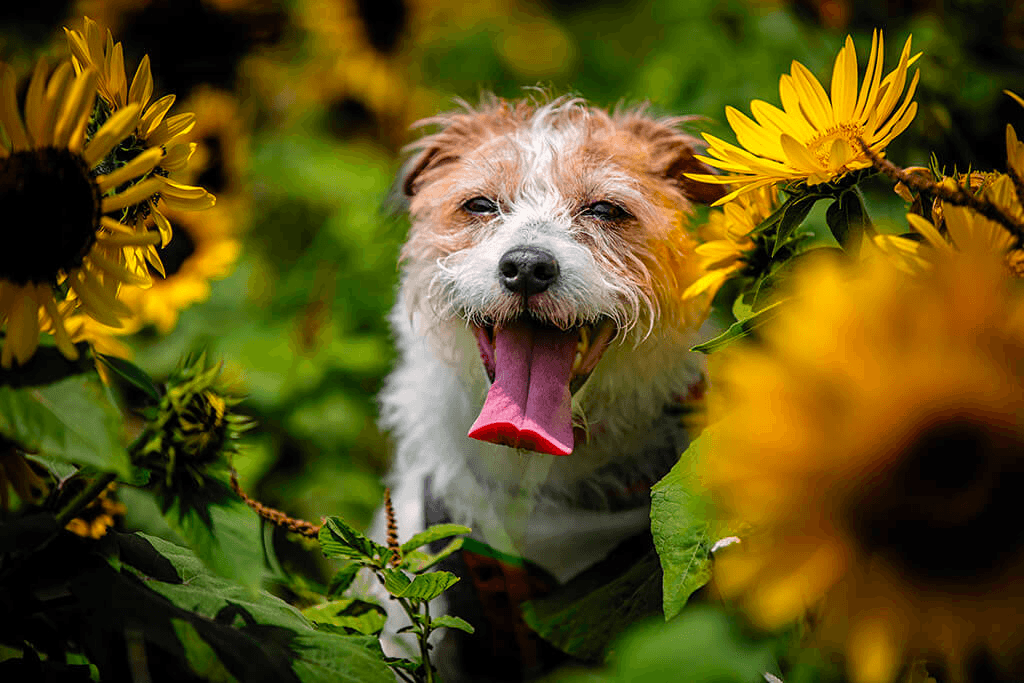Discover the causes and symptoms of blood in dog poop, along with effective solutions to help your furry friend.
- Home/
- Dog/
- Health & Wellness/
- Blood in Dog Poop: 12 Possible Causes & When to See a Vet
Blood in Dog Poop: 12 Possible Causes & When to See a Vet

Seeing blood in your dog’s poop can be alarming for pet owners, but it isn’t always a reason to panic. There are a range of minor issues that can cause small amounts of bloody stool, such as dietary indiscretion, parasites, or even stress. However, persistent or significant blood in the stool can be more concerning.
Recognizing the different types of blood in poop—bright red, dark, or jelly-like— and monitoring for other signs of illness can provide important clues about the potential source of the problem and when urgent vet care may be needed.
Here, we will explore possible causes and symptoms of bloody stool to help pet parents make informed decisions about their dog’s health and ensure their furry friend receives the care they need.
What Does Blood in Dog Poop Look Like?
There are many potential causes of bloody stool. The amount and appearance of blood can provide clues to you and your vet about what might be going on.
- Bright red blood in dog poop – This condition, known as hematochezia, indicates the presence of fresh blood, typically from the lower digestive tract, anus, or anal glands. If a dog is bleeding from multiple orifices, this is concerning for a bleeding disorder, such as rodenticide toxicity.
- Dark/black blood in dog poop – Often described as having an appearance similar to coffee grounds, this is the appearance of digested blood (medically known as melena). Its presence indicates that there may be bleeding from the stomach or upper intestines. Melena may also occur if a dog has ingested a large amount of blood, for example, due to bleeding in the mouth or nose, or from licking a wound.
- Jelly-like blood in dog poop – The presence of mucus along with blood is common in conditions such as colitis (inflammation of the large intestine). Large blood clots may also be seen with conditions such as hemorrhagic gastroenteritis.
Bloody stool may or may not be accompanied by other symptoms, such as diarrhea, urgency, or straining to defecate. If it is accompanied by vomiting, loss of appetite, lethargy, or pale gums, then urgent veterinary care is required.
The appearance of your dog’s poop can tell a lot about their overall health. When cleaning up after your dog it’s important to keep an eye out for any abnormalities in color or consistency and alert your vet to any concerns.

Possible Causes of Blood in Dog Poop
Bloody stool results from inflammation in the bowels, of which there are many possible causes ranging from minor to severe. Some of the more common causes include:
Colitis
The term colitis simply means inflammation of the colon (large intestine). It can occur due to various causes and often leads to diarrhea, defecating small frequent amounts (urgency), straining to defecate, and blood and/or mucus in the stool. Other symptoms, such as loss of appetite, vomiting, and weight loss, are less common.
Dietary indiscretion
Dogs are often indiscriminate eaters. If they get into something they shouldn’t, whether it’s garbage, human foods, or the kitty litter, it can lead to gastrointestinal upset such as diarrhea with or without blood, vomiting, and loss of appetite. If a dog eats an object that is large or non-digestible, it may become lodged in the intestines causing a life-threatening obstruction.
Food allergies, intolerances, or abrupt diet change
Sensitivity to certain ingredients can trigger inflammation in the gut. Some dogs may be allergic (have an overactive immune response) to an ingredient in their diet, most often the protein source. These dogs often have skin reactions as well, including pruritus (itchy skin), redness, hair loss, and recurrent skin and ear infections.
Novel ingredient or hydrolyzed protein diets may be needed for dogs with food allergies. Whether or not your dog has sensitivities, abrupt diet changes can lead to GI upset, so if you opt to change your dog’s diet, make the transition gradually over about a week.
Stress
Stress colitis is a common occurrence in dogs, especially those dealing with major life changes like moving home or staying at a boarding facility. Mild diarrhea with or without streaks of bright red blood in a dog who is otherwise normal is the typical scenario.

Parasites and protozoa
There are several types of intestinal parasites that can cause diarrhea and vomiting, such as hookworms, whipworms, roundworms, giardia, and more. Some attach to the intestinal wall, leading to bleeding and irritation. Checking a fecal sample yearly and keeping up to date on a broad spectrum flea, heartworm, and parasite preventative is the best way to help protect your dog.
Infections
Viral infections (such as parvovirus) and bacterial infections (such as salmonella and E. coli) are possible causes of bloody diarrhea. Your dog could get these infections from contact with infected animals, objects, or contaminated foods. Help protect your pup from these conditions by following your veterinarian’s recommendations for vaccinations, staying away from sick dogs, and not feeding raw diets.
Inflammatory bowel disease (IBD)
Inflammatory bowel disease is a chronic and complex condition that involves ongoing inflammation in the digestive tract, vomiting, weight loss, and/or diarrhea.
Hemorrhagic gastroenteritis (HGE)
Hemorrhagic gastroenteritis in dogs is a significant cause of blood in stool. Also known as acute hemorrhagic diarrhea syndrome, this is a serious condition that causes sudden and severe bloody diarrhea that is often described as “raspberry jam”. Other symptoms include vomiting, lethargy, decreased appetite, and significant dehydration. HGE may be triggered by bacterial infections (such as clostridium), stress, dietary indiscretion, and more, and requires emergent veterinary care.
Tumors, polyps, or trauma
Tumors or growths can occur anywhere on the body, including the colon, rectum, anus, and anal glands. If these growths become ulcerated or irritated, they may bleed. Injury or infection in these areas (for example, an anal gland abscess) could also result in bright red blood coating the feces.

Ingesting toxins or medications
Certain medications, especially non-steroidal anti-inflammatory drugs like ibuprofen or aspirin, can irritate the stomach and intestinal lining, leading to bleeding ulcers. Additionally, ingesting toxins, such as anticoagulant rat poison, can affect blood clotting and lead to internal bleeding. Never give your dog human medications. If you suspect your dog has ingested something toxic, contact your veterinarian, ASPCA, or the Pet Poison Helpline immediately.
Bleeding or blood clotting disorders
Some dogs may have inherited bleeding disorders like von Willebrand’s disease, while others may develop them due to underlying health conditions or exposure to certain toxins. These conditions disrupt the body’s ability to form blood clots, potentially leading to bleeding in various parts of the body, including the digestive tract, and require prompt veterinary treatment.
Systemic disease
Systemic diseases, which affect the entire body, can also cause blood in your dog’s stool. For example, kidney failure can result in ulcerations and anemia, liver disease can affect blood clotting, and certain cancers and immune-mediated diseases can also cause internal bleeding.
If a dog has blood in stool accompanied by other signs of illness like lethargy, weight loss, or changes in urination or drinking habits, a veterinary examination is needed to identify and treat any underlying systemic disease.
What Does Blood in Dog Poop Mean?
The presence of blood in your dog’s poop usually means that there is inflammation occurring in their gut. As discussed, this may be due to something minor, such as an abrupt diet change or stress, or a significant disease process, such as HGE or kidney failure. Therefore, it’s important to consider the context.
Did your dog get into something they shouldn’t have? Have there been any triggers or changes in routine that could be causing stress? How are they feeling otherwise? A small amount of bloody diarrhea in a dog who is otherwise normal is much less concerning than in a dog who is also showing other signs of illness, such as vomiting, lethargy, and loss of appetite.

When to See a Vet
Minor instances of blood in dog poop in a dog who is otherwise acting normal may resolve at home with close monitoring and supportive care, such as a bland diet and probiotics. However, if you notice the following, you should schedule an appointment with your vet right away.
- Persistent or worsening bloody stool
- Persistent or worsening diarrhea
- Large amounts of bloody stool, pooping straight blood, or bleeding from other orifices
- Vomiting
- Decreased appetite
- Lethargy or weakness
- Pale gums
- Significant discomfort or changes in behavior
- Known toxin ingestion
- Collapse or seizure
- Symptoms in a puppy, senior, or dog with preexisting medical conditions
In some cases bloody stool can be a medical emergency. It’s important to trust your instincts and see your vet with any concerns. Be prepared to provide information about your dog’s diet, lifestyle, symptoms, and medications, and bring a fresh fecal sample.
Diagnosis & Treatment
Your vet will begin by getting a complete medical history and performing a thorough physical exam, including a rectal exam. They may then recommend some or all of the following diagnostic tests:
Fecal exam
A stool sample can be analyzed to check for parasites, bacteria, and other microscopic evidence of inflammation or infection.
Bloodwork
Bloodwork can reveal signs of infection, anemia (low red blood cell count), clotting disorders, organ function (liver, kidneys), and electrolyte levels, which can be helpful in cases of dehydration or systemic illness.
Imaging
X-rays can help visualize the intestines and identify potential foreign objects, tumors, or blockages. An abdominal ultrasound provides a more detailed view of the organs and can detect inflammation, masses, or other abnormalities.
Endoscopy, colonoscopy, exploratory surgery, or biopsy
In some cases, a more invasive procedure like a colonoscopy (to examine the colon), endoscopy (to examine the stomach and small intestine), or exploratory abdominal surgery may be necessary to visualize the lining of the digestive tract, obtain biopsies, and identify any abnormalities.
Medication or diet trial
In some cases, dogs may have only minor symptoms or pet parents may not want to pursue extensive testing, so a diet or mediation trial could be considered. If your vet suspects a specific condition, such as inflammatory bowel disease (IBD), they may prescribe medications (e.g., anti-inflammatories or antibiotics) to see if it resolves the bloody stool. In cases of suspected food allergies or sensitivities, your vet may recommend a hypoallergenic diet trial. This involves feeding your dog a novel protein source (one they haven’t eaten before) or a hydrolyzed protein diet for several weeks to see if the symptoms improve. These trials can help manage symptoms, confirm the diagnosis, and guide long-term treatment.
Treatment will depend on the severity of your dog’s symptoms and the underlying cause, and may include dietary adjustments, deworming or antiparasitic medications, antibiotics for infections, anti-inflammatory or immunosuppressive medications for IBD, and advanced care (such as hospitalization for IV fluids or blood transfusion) for serious conditions like HGE or bleeding disorders.

Prevention Tips for Healthy Dog Digestion
Vomiting and diarrhea are bound to happen from time to time. However, to help keep your dog’s GI health in top shape, consider the following vet-approved tips:
- Provide a high-quality diet that is completely balanced and appropriate for their life stage
- Avoid raw food, which can be contaminated with bacteria and parasites
- Limit treats and people food to less than 10% of your dog’s daily calories
- Avoid giving dogs access to harmful or toxic items, including human medications
- Get regular vet check-ups to catch issues early when they may be easier and less costly to treat
- Get fecal testing yearly or as recommended by your vet
- Use a board spectrum product to prevent internal and external parasites
- Monitor for early signs of digestive distress and contact your vet with any changes or concerns
Blood in Dog Poop Final Thoughts
Whether it’s due to something minor (such as dietary indiscretion or an anal gland infection) or a more concerning condition (such as hemorrhagic gastroenteritis or inflammatory bowel disease), it’s best to check in with your vet if you notice blood in dog poop, especially if it is persistent, severe, or accompanied by other symptoms. Cleaning up dog poop is nobody’s favorite job, yet it can provide important insights into your furry family member’s digestive and overall health.
FAQs
Why does my dog have blood in his poop?
Melena, the presence of black, tarry stools, signals bleeding in the upper digestive tract, such as the stomach or small intestines. This blood has been digested, giving it a dark, sticky appearance. Possible causes include ulcers, foreign objects, tumors, and even clotting disorders. In contrast, hematochezia, characterized by bright red blood, usually indicates bleeding lower down in the colon or rectum. This could be due to colitis, anal gland problems, infections, or even something as simple as dietary indiscretion or stress. Both melena and hematochezia warrant veterinary attention to identify the underlying cause and ensure appropriate treatment.
What causes streaks of blood in dog poop?
Streaks of bright red blood coating the outside of a dog’s feces may be due to bleeding associated with infection, inflammation, parasites, or injury in the colon, rectum, anus, or anal glands. Other common causes are discussed above.
Will blood in dog stool go away on its own?
Minor cases of bloody diarrhea may resolve on their own or with at-home care, such as a bland diet and probiotics, within a couple of days. However, if your dog is showing other symptoms of illness or the blood is persistent or severe, it’s important to see your vet as soon as possible.
Can dogs die from bloody stools?
Certain conditions, such as rodenticide poisoning, bleeding disorders, HGE, and systemic diseases, may be fatal if not promptly addressed by your vet. However, many cases of bloody stool are mild and easily treatable.
Sources
https://veterinarypartner.vin.com/default.aspx?pid=19239&id=4952857
https://www.merckvetmanual.com/dog-owners/blood-disorders-of-dogs/bleeding-disorders-of-dogs
https://www.petmd.com/dog/nutrition/what-to-feed-a-dog-with-diarrhea
 L
L



